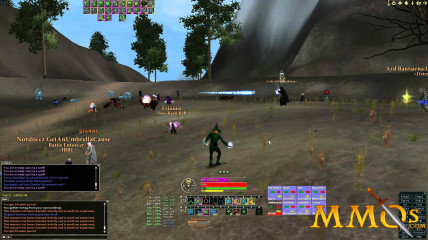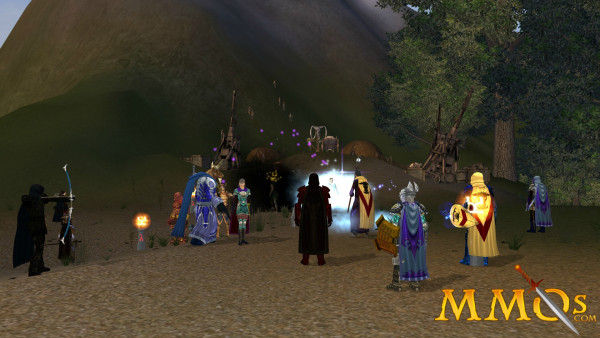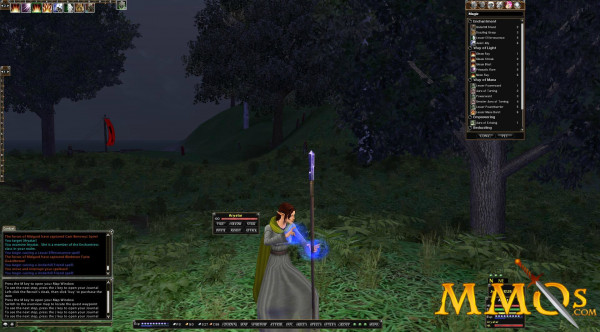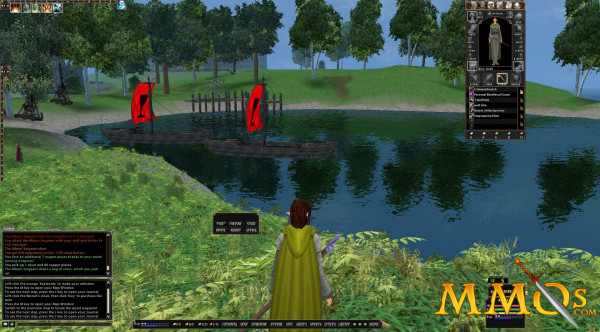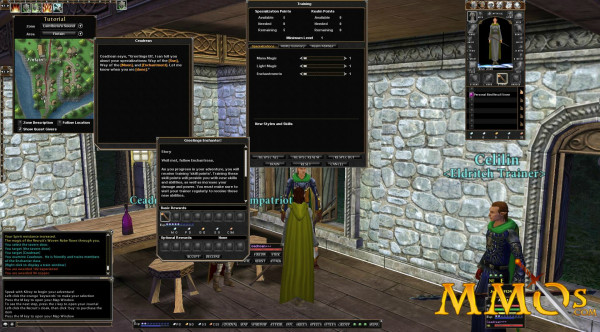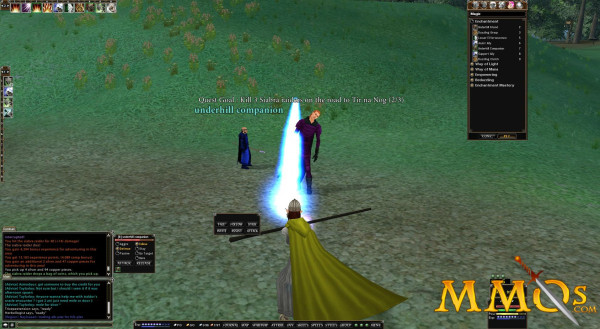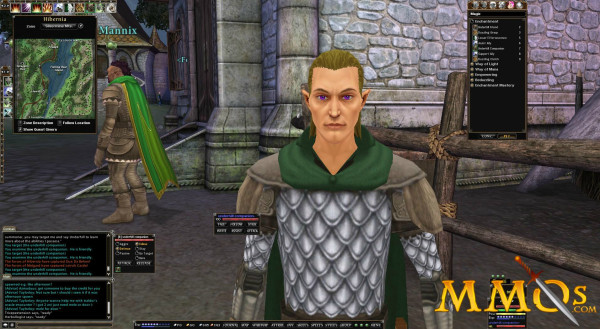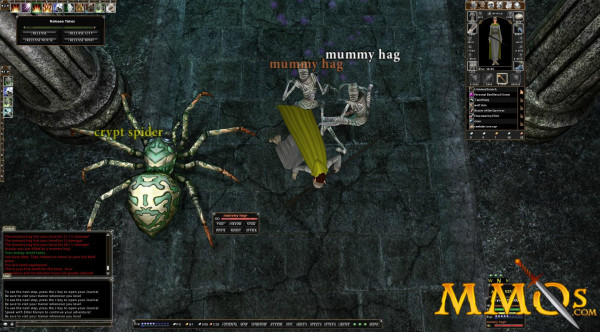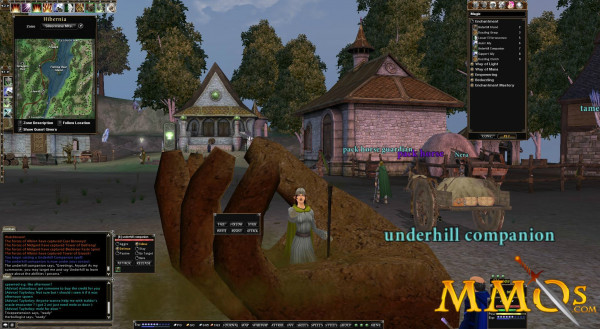Dark Age of Camelot
Dark Age of Camelot is a medieval fantasy MMORPG set in the time after King Athur’s death, as his kingdom splits into three warring factions. Choose from 3 factions, 21 races, and 45 classes to travel across a mythological world with monsters, dungeons, and Realm versus Realm PvP.
| Publisher: Electronic Arts Playerbase: Low Type: Subscription MMORPG Release Date: October 10, 2001 PvP: Realm v. Realm Pros: +Huge catalog of classes/races. +Loads of content to explore. +Epic RvR combat (Pioneered the genre!) Cons: -Tedious and clunky UI. -Steep learning curve. -Dated graphics may turn away new players. -Some balance issues. |
Dark Age of Camelot Overview
Dark Age of Camelot (DAoC) is a medieval fantasy MMORPG developed by Mythic Entertainment. First released in 2001, DAoC remains one of the longest running MMORPGs, along with Ultima Online and EverQuest. Taking place after the death of King Arthur, the world of DAoC is torn between three rivaling nations vying for control of the world. Choose from 21 races and 45 classes, unique to each realm, and employ a range of abilities to level up to 50 and conquer your neighbors. PvP is a massive battleground where the three nations meet and fight in objective-based combat, for control of keeps and land. The world is rich with lore, based on Arthurian, Norse, and Celtic mythology, with areas inspired by real world locations. Engage in a player economy, and earn enough gold to purchase your own house, setting up shop to dominate the market with exquisite goods from your travels. Dark Age of Camelot has had seven free expansions, offering a huge amount of content to be experienced.
Dark Age of Camelot Key Features:
- Tons of Races and Classes – choose from 21 races and 45 classes, both being unique to the realm you choose with intricate lore and starting zones.
- Realm versus Realm Combat – three-way PvP battleground with objective-based combat.
- Rich Lore – based on the aftermath of King Arthur's death in a sprawling medieval fantasy world.
- Housing System – lets wealthy players purchase real estate and hire merchants to sell collected loot and gear.
- Huge Amounts of Content – seven free expansions have greatly expanded the lore and world of DAoC.
Dark Age of Camelot Screenshots
Dark Age of Camelot Featured Video
Dark Age of Camelot Review
By Sean Sullivan
A story set in mythology is the perfect opportunity for an MMORPG. It’s surprising that more games don’t capitalize on our rich history of legends. I’m sure many games are inspired by tales of old, but reskin the story with cartoony Blizzard sprites or inject them with a science fiction backdrop. Dark Age of Camelot throws you into the midst of conflict following King Arthur’s death. The curtain has closed on the epic tale of Arthur, Excalibur, and the Knights of the Round Table, and his absence plunges the kingdom into chaos, with three nations throttling each others' throats. Dark Age of Camelot has long been hailed as a pivotal moment in the development of MMORPGs, instituting a PvP system and lore that most developers fail to capture. Only Mythic Entertainment could deliver a tale seeped in Arthurian lore, Norse mythology, and Celtic legends to create game that continues to influence MMORPGs today.
An Adventure Unfolds
Starting off, you elect to play as one of three factions—Albion, Hibernia, or Midgard, each corresponding to Arthur's kingdom, Norse lands, or Celtic legends respectively. I chose Hibernia, peoples attuned to nature and the conservation movement—races willing to chain themselves to Redwoods and spit in the face of land developers. Mainly, I chose Hibernia, not just because it exemplifies my own heritage as a Celt, but to play as an Enchanter. From what I had been told Enchanters are overpowered—or at least they were ten years ago when friends of mine played. As someone with no experience until now I heeded their advice.
Character creation is fairly simple, in line with other MMORPGs of the time period. Although there is a huge selection of races and classes to choose from—21 races and 45 classes across the three realms—character customization is rather limited. 2001 was a time before sliders and Black Desert Online, so players settled for a menagerie made up of pre-designated faces and hair colors. Following my friends advice I chose a race that could play as an Enchanter, meaning either an Elf or a Lurikeen. I chose the pointy eared elf (because I am also beautiful, tall, and thin), hoping to use my ears as daggers in an emergency situation. As an Enchanter I can summon citizens of the “Underhill” to assist me in battle, and employ the magic of the Sun, Moon, and enchanting powers. I appreciate how DAoC draws on druid mythology as well as other ancient mythologies. It adds a sense of foundation beyond the game's internal lore.
King Arthur’s Landscape
The graphics are surprisingly not that bad, even by today's 4k texture ideal. The water effects in particular look excellent, with slight ripples reflecting the world and shimmering as the sun hangs overhead; the game world actually looks better in the distorted reflection of a stagnant river. It’s a little rough around the edges, but there is enough detail in trees and foliage to give it sharp definition. Character models are realistic with defined features, bags under the eyes and raised ridge-lines. But their facial expressions, as expected, are like mannequins. The most life they breathe is their shifting weight as they wait patiently for some adventurer to talk to them. And some subtle touches like wispy clouds floating by in the daytime sky give the world some life—not that the wandering hordes of confused enemy NPCs don't make it feel lived in. Day/night cycles and weather effects evoke the sense of a breathing world, one that continues to spin even after you’ve logged off.
The sound effects are on par with every other game of the time. Your character grunts as she gets hit, spells have a charming, channeling effect, and the sound of an idle breeze plays constantly in the background of the game. Ocean tides weave in and out of your speakers, but the lack of any animation causes dissonance that forces you to imagine the breaking waves. Playing with the game’s sound options, I left everything on except “Ambient Sounds Volume.” Once it’s off, the game world becomes like an anechoic chamber. I think my game was bugged, as music faded in and out, but when it was playing it was well situated to the environment, a subtle orchestra mimicking the fantastical nature of the game. It's all well situated for the game world. Compared to modern games DAoC looks and sounds like it belongs on mobile devices, calling upon games like Celtic Heroes. If EA did publish it on mobile, I might actually use my tablet for gaming.
Right Foot, Then Left Foot
Dark Age of Camelot’s biggest drawback is its user interface. After fifteen years you would think somebody in a meeting at Mythic or Electronic Arts would say something. If you maximize your resolution to the commonly desired 1920 x 1080, you’ll immediately notice some awful scaling. The windows become all teensy-tiny, to the point that a window’s “X” blends in with its border. I can barely make out my character sheet in the top-right portion of my screen. My enchanter looks like a shrunken voodoo doll, ready for someone to stick pins into because they disagree with my opinion. My eyes are already strained enough by the constant glare of my LED backlit monitor, but squinting to make out basic elements in the game only exasperated my impending blindness. Of course, DAoC is a game made in 2001, back when 16 x 9 monitors weren’t even a thought, and Dell was making money supplying schools with manila CRV monitors. But it's 2015 and the poor UI makes new players want to alt + f4 before even talking to the first NPC. Simply realigning some elements to give it a modern approach could attract new players.
Enchanting My Way To Victory
You don’t need to look up a recipe to understand DAoC’s combat system. Find your target, whether it be a pacifist wolf or Midgard scum simply following orders, left-click to select, and begin tearing them apart limb by limb. As an Enchanter I ran up to a fearsome wolf to end the tyranny of the four legged beasts. Selecting the target, the wolf’s name changes to grey, indicating that I have the vile creature in my staff's ironsights. I start by casting Misleading Rapture, dealing damage and decreasing my target's resistance to heat by 10 percent. Channeling a little ball of energy, I hurl it at my enemy watching sparkles fly above their head and then proceed to pummel his furry skull with my staff.
As you level you unlock new abilities. Almost every level gives you a new ability to use, to the point that it becomes overwhelming—a feeling I miss in modern games. As an enchanter, by Level 6 you have a huge library of spells to employ in combat. Variety and tactics, that’s what makes an MMORPG immersive. So, by Level 6 I have the ability to stun, lower resistances, and dish out huge damage. I start by lowering my target's resistances to heat and dealing damage, then stunning, then unleashing the glass cannon and firing a heatwave to make even the East Coast of the U.S. thirsty.
But issues arise due to the seemingly clunky UI. Everything feels disjointed by modern standards. Hotkeyed skills are located in the top-left hand corner of your screen by default, while an action box with “Attack,” “Follow,” “Invite,” and others idle next to your character model. Again, simple remodeling to bring the default UI in line with common practice would make it more accessible. You can go and customize to your liking, but no new player wants to spend time rearranging their interface before killing the first kobold.
Living Mythology
Traveling Hibernia, my world was littered with Celtic references, such as the Cliffs of Moher and Lough Derg—both locations in Ireland. While many of DAoC’s characters are mythological, or fantastical, the world they inhabit seems real enough, and the game's story maintains an atmosphere of mythological authenticity. Wandering NPCs like the pack horse guardian and his steed give it a lived-in atmosphere, adding a touch of charm to a landscape littered with the corpses of aggressive mobs. Castles and forts scatter the landscape, mirroring Europe’s overabundance of self-declared kings, barons, and lords.
But navigating the world can be difficult. Maps are constrained to an immediate area and their corresponding zones. And the small UI makes distinguishing landmarks on the map a chore. You can’t zoom in so your character’s marker can easily be lost among NPC markers and quest markers. Paying attention to the description of a quest is paramount to figuring out where to head to next. Some quests transported me to new zones, disorienting my idea of where I was in the world, and leading to my death more than once. It’s another issue that could be rectified by overhauling the UI.
Grinding
You progress through the game by completing quests, taking you across the mythical universe of a post-Arthurian landscape. Rather than luminous exclamation points, golden viking symbols spin atop NPC domes, indicating their need for Spider Silk, or whatever else may be troubling them. It’s an upgrade from EverQuest, where tasks had to be discerned from an NPC’s name. Although, unlike EverQuest, you won’t be grinding your way to the max level (50). Instead you’ll travel across the landscape, satisfying NPCs' desires and crawling through dungeons.
The world is broken into leveled zones, so that as you’re leveling you’re also moving across the world, much like any modern MMO. And the corresponding zones offer new dungeons to be conquered alone or with a party, complete with dungeon-specific quests. World of Warcraft certainly took part of its inspiration from DAoC. And along the way you’ll encounter repeatable battleground quests, pitting you against players and NPCs of opposing factions. The level gap restricting these quests is small, about four levels, meaning that players are on even ground while slaughtering each other; unlike some games where battlegrounds are filled with a wide range of player levels, leading to the higher levels dominating the battlefield.
PvP
In the normal servers, such as Ywain, PvP is limited to designated areas. There used to be PvP servers, but they closed in April 2013. But what remains of DAoC’s PvP still deserves the award it received from Ten Ton Hammer in 2010 for Best PvP Game of the Decade. DAoC’s three realms are at war, foreign countries steeped in their own culture hungry to conquer their neighbors. Battlegrounds pit Realms against one another, limited to a small range of levels to prevent any one player from dominating. Keeps are scattered on the battlefield, available for capture—like Ragnarok Online’s War of Emperium—and must then be defended from invading players.
Final Verdict – Excellent
Along with games like Ultima Online and Everquest, Dark Age of Camelot paved the way for the surfeit of MMORPGs available today. A clunky user interface can distract from DAoC’s legacy as a pivotal game. But the superabundance of races and classes has rarely been replicated, and three-way Realm versus Realm combat continues to excite the nostalgia of veteran players. All the while, the world, steeped in mythology and lore, offers a mature setting for its gameplay. If you’re tired of modern MMORPGs or want to experience the early days of a genre, go download Dark Age of Camelot.
Dark Age of Camelot Videos
Dark Age of Camelot Links
Dark Age of Camelot Official Site
Dark Age of Camelot Wikipedia
Dark Age of Camelot Reddit
Dark Age of Camelot Wikia [Database/Guides]
Dark Age of Camelot System Requirements
Minimum Requirements:
Operating System: Windows XP, Windows Vista, or Windows 7
CPU: Pentium 4 2.0 GHz or equivalent
Video Card: 3D acceleration card with 64 MB video RAM
RAM: 512 MB
Hard Disk Space: 3.5 GB
Recommended Requirements:
Operating System: Windows XP, Windows Vista, or Windows 7
CPU: Pentium 4 3.0 GHz or equivalent
Video Card: 256 MB ATI X800 or Nvidia GeForce 6800 series or higher
RAM: 1 GB or more
Hard Disk Space: 3.5 GB
Dark Age of Camelot Music & Soundtrack
Dark Age of Camelot Additional Information
Developer(s): Mythic Entertainment, Brosword Online Games
Publisher(s): Vivendi Games, Electronic Arts
Designer(s): Mark Jacobs, Matt Firor, Rob Denton
Engine: Gamebryo (originally NetImmerse 3.0 engine), Foliage: SpeedTree
Release Date: October 10, 2001
EU Release Date: February, 2002
Expansions:
- Shrouded Isles: November 12, 2002
- Foundations: June 18, 2003
- Trials of Atlantis: October 28, 2003
- New Frontiers: June 22, 2004
- Catacombs: December 7, 2004
- Darkness Rising: October 11, 2005
- Labyrinth of the Minotaur: November 5, 2006
- New New Frontiers (Patch): September 5, 2015
Development History / Background:
Dark Age of Camelot was developed by Mythic Entertainment. Basing the game world on the Arthurian legend was proposed by Mythic Entertainment president Mark Jacobs, because the legend was in the public domain and free of licensing issues. Development costs exceeded $2.5 million, with 25 full-time developers working for 18 months. After being repeatedly rejected, DAoC was published by Vivendi Games. 51,000 copies of DAoC were sold in the first 4 days of release, and the subscriber base rose to nearly 250,000 by July 2002. At the time the leetspeak expression “QQ” was born on a Dark Age of Camelot message board, and subsequently spread to other games. In 2010 Dark Age of Camelot was awarded Best PvP Game of the Decade by Ten Ton Hammer. On December 23, 2012 Camelot Unchained was announced as the spiritual successor to Dark Age of Camelot, under production by Mark Jacobs with City State Entertainment. The designer announced that the game would be PvP-centric, with three realms once again warring for control.
